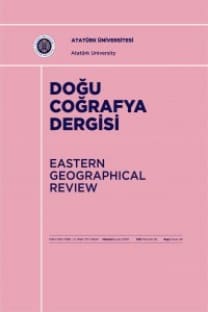Ütopik coğrafyalar: On sekizinci yüzyıl Avrupa haritalarındaki kartuşların söylemsel (discoursive) Analizi
Bu çalışmada eski haritaların dekoratif sanatı, özellikle de kartuşları, deşifre edilecek kültürel metinler olarak ele alan bakış açısıyla incelenecektir. Buradan yola çıkarak, tanımlayıcı yöntemlere başvurmak suretiyle kartuş yapımcılarının zihinleri ile ütopik coğrafyalar arasında bir köprü kurulmaya çalışılacaktır. Böylece, kolonileştirilmiş Kuzey Amerika’nın ve Kızılderililerin yaratıcı coğrafî tasavvurlarını dikkatlice gözden geçirmek amacıyla 1700’lerin (özellikle) İngiliz kartuşlarını eleştirel bir inceleme zeminine taşıyarak analiz edilecektir. Bu araştırmayı sonuçlandırmak üzere mantıkî sosyal belleğin arkasındaki itici gücü anlamak için zaman ve mekân olarak kartuş yapım tarihine uzanılacaktır. Ayrıca, bazı XVIII. yüzyıl Avrupa (İngiliz ve Fransız) kartuşları tarihin görgü tanıkları olarak değerlendirilecektir.
Imagined geographies: a discursive analysis of eighteen century European cartouches
Cartouches – as nonverbal sign systems- can be understood as socially constructed, laden with meanings and historical impositions over physical spaces, peoples, and geographic events. Cartouches are never neutral or free from politics of power in the position of constructing and formulating physical and imagined topographies. Cartouches are embedded with rhetorical images so that others (not ‘us’) can be described, pictured, or created. Therefore, cartouche making was never independently (value-free) ornamented nor objectively and purely implicated activities.In this paper, I investigate decorative art of early maps especially cartouches from the vantage point in which cartouches are considered as cultural texts to be decoded. From this departure, I will try to apply the descriptive methodology to make my point, which is to establish a bridge between cartouche makers’ minds and the geographic imagination. In doing so, I will bring 1700s’ English cartouches on the stage of my critical investigation and discursive analysis to scrutinize their creative geographic imagination of colonized North America and Amerindians. To accomplish this quest I will travel through the history of cartouche making in time and space to understand the driving force behind this discursive social register.
___
- Binding, P. 2003. Imagined Corners: Exploring the World’s First Atlas. London: Headline Book Publishing.
- Clarke, G.N.G. 1988. Taking possession: the cartouche as cultural text in eighteenth-century American maps. World & Image, Vol. 4, No. 2, pp. 455-474.
- Cosgrove, D.E. 2001. Apollo’s eye: a cartographic genealogy of the earth in the western imagination. Baltimore: The Johns Hopkins University Press.
- Harley, J.B.1988. Maps, Knowledge and Power. In The New Nature of Maps: Essays in the History of Cartography Ed. Paul Laxton, Baltimore, The johns Hopkins University Press: pp. 51-83, 2001.
- Harley, J.B.1990. Text and Context in the interpretation of Early Maps. In The New Nature of Maps: Essays in the History of Cartography Ed. Paul Laxton, Baltimore, The johns Hopkins University Press: pp. 33-51, 2001.
- Harley, J.B.1997. Power and Legitimation in the English Geographical Atlases of the Eighteenth Century. In The New Nature of Maps: Essays in the History of Cartography Ed. Paul Laxton, Baltimore, The johns Hopkins University Press: pp. 109-149, 2001.
- Imago Mundi, 1975. Cartouches. Volume 27, pp. 8+18+22+26+38+46+64+72.
- Johnstone, B. 2008. Discourse Analysis. Malden, MA: Blackwell Publishing.
- Raisz, E. 1938. General Geography, 351. London, McGraw-Hill Publishing Co.
- Rees, Ronald. 1980. American Geographical Society. Vol. 70, No. 1, pp. 61-78.
- Said, E. 2003. Orientalism. New York: Penguin Books
- Smith, C.D. 1985. Cartographic Signs on European Maps and their Explanation before 1700. Imago Mundi, Vol. 37, pp. 9-29.
- Tuan, Yi-Fu, 1975. Images and Mental Maps. Annals of the Association of American Geographers, Vol. 65, No. 2, pp. 205-213.
- ISSN: 1302-7956
- Yayın Aralığı: Yılda 2 Sayı
- Başlangıç: 1995
- Yayıncı: Prof.Dr. İbrahim Fevzi ŞAHİN
Sayıdaki Diğer Makaleler
CUMHURİYET DÖNEMİNDE (1927-2008) ERZURUM İLİNİN KIR-ŞEHİR NÜFUS DEĞİŞİMİ
Cumhuriyet döneminde Erzurum ilinin Kır-Şehir nüfus değişimi
CARL ORTWIN SAUER VE KÜLTÜREL COĞRAFYA
Popüler bilim anlayışı ve coğrafyanın popülerliği, Bilim ve Teknik Dergisi örneği
ÇEVRECİ BARAJLARA GEÇMİŞTEN BİR ÖRNEK: TURNA (KEŞİŞ) GÖLÜ
